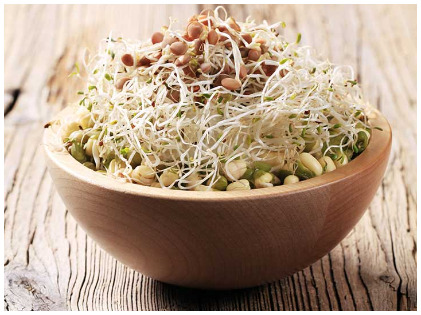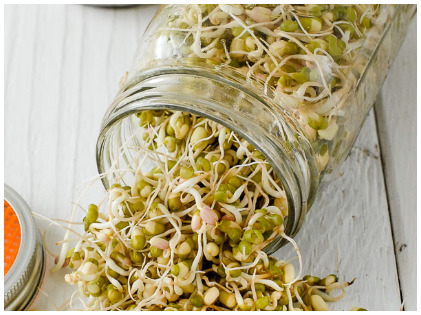Here Are All The Tips You Need To Hop Onto the Sprouting Bandwagon!
Have you ever tried growing your own pulse or beans for fun as a child? It was incredibly exciting when each seed started growing a tiny tail, right? The fascinating idea of sprouting shouldn’t be limited to childhood memories, though! There are many reasons for you to start sprouting again, but this time, you have to incorporate them into your meals. There is a variety of seeds to select from to sprout, and virtually any vegetable seed can be consumed as sprouts. Here’s everything you need to know to start right now!
Why You Should Be Eating Sprouts
 When seeds germinate or sprout, their mineral and vitamin levels multiply substantially. Also, if you have a sensitive system, you’ll be glad to know that sprouting eliminates much of the gas-producing starches in legumes and grains. The protein content of the seed increases as well, and vitamin C is manufactured in the sprout. This is simply phenomenal – and you should actually be more fascinated about it now than you were as a kid. Sprouts help with digestion, blood circulation, weight loss, immune system protection, and eyesight improvement. They are heart-friendly and help reduce acidity in the body. There are even studies that support they may prevent premature aging! The benefits don’t end here – there’s a host of benefits for your hair as well like minimizing dandruff, increasing biotin, and preventing premature greying, among many others.
When seeds germinate or sprout, their mineral and vitamin levels multiply substantially. Also, if you have a sensitive system, you’ll be glad to know that sprouting eliminates much of the gas-producing starches in legumes and grains. The protein content of the seed increases as well, and vitamin C is manufactured in the sprout. This is simply phenomenal – and you should actually be more fascinated about it now than you were as a kid. Sprouts help with digestion, blood circulation, weight loss, immune system protection, and eyesight improvement. They are heart-friendly and help reduce acidity in the body. There are even studies that support they may prevent premature aging! The benefits don’t end here – there’s a host of benefits for your hair as well like minimizing dandruff, increasing biotin, and preventing premature greying, among many others.
The Basic Method of Sprouting
Rinse your chosen seeds and cover with cool water. Allow to soak for a minimum of eight hours or longer if the seeds are larger (up to 24 hours for large beans and legumes). The seeds must then be rinsed and drained three times a day for 2 to 3 days for sprouts to form.
![]() Tips on Preparing Sprouts
Tips on Preparing Sprouts
a.) When you’re choosing the jar in which you are going to sprout your seeds, a good tip is to choose one with a mesh cap which is particularly useful for sprouting very small seeds. Alternatively, you could modify your jar for the lid to tighten over a fine cloth or mesh to make draining easier when you rinse your sprouts.
b.) If you have a mesh bag or a sack with a mesh fine enough for air to flow through your seeds, consider sprouting in a sack. This is particularly good for larger seeds. Try linen or muslin cloth and stitch your own bag which you can hang up. This makes draining easy, too!
c.) Try sprouting seeds in a tray for long sprouts like alfalfa. The big benefit here is that the sprouts will grow vertically in a tray. Choose any well-draining, flat tray like deli trays or plastic grow trays. Mist with water to avoid damaging tender sprouts.
Safety Tips for the Home Sprouter
a.) Always use clean water to sprout your seeds — preferably filtered.
b.) Avoid having water standing in the sprout container after the soaking period. Sprouts should be moist but not soaking while sprouting
c.) The soaking water becomes heavy with starch and other components, and so, the seeds need a thorough rinse before they are left in a vessel to sprout.
d.) Be especially careful during warm weather as bacteria can easily spread. Rinse more frequently if it is humid and hot. Ensure proper airflow.
e.) When storing sprouts, store without rinsing and allow for good airflow during storage in the refrigerator. Consume within 5 to 7 days.
![]() Tips on How To Add Sprouts to Your Diet
Tips on How To Add Sprouts to Your Diet
a.) You may use your sprouts by dehydrating them and milling them into a flour, in which case you should sprout your seeds just until the tail of the sprout is visible. This is also a good sprout for cooking.
b.) If you happen to be a fan of juicing, sprout the grains until the tip of the tail is visible then transfer to the soil to grow as a grass.
c.) Legumes should be sprouted until the sprout tail appears — or even a little longer but always before leaves appear.
d.) You may taste your sprouts daily until you have achieved your desired taste.
e.) You may even sprout seeds in a jar at first until the tip of the sprout emerges. Then, transfer to a tray for growing longer sprouts. At this point, you could cover the sprouts with light potting soil to grow a microgreen mix.
You now have all the information you need to get started with sprouting! Enjoy your sprouts in stir-fries, smoothies, juices, omelets, salads, soups, stews, sauces, pastes, and much more.

 Tips on Preparing Sprouts
Tips on Preparing Sprouts Tips on How To Add Sprouts to Your Diet
Tips on How To Add Sprouts to Your Diet